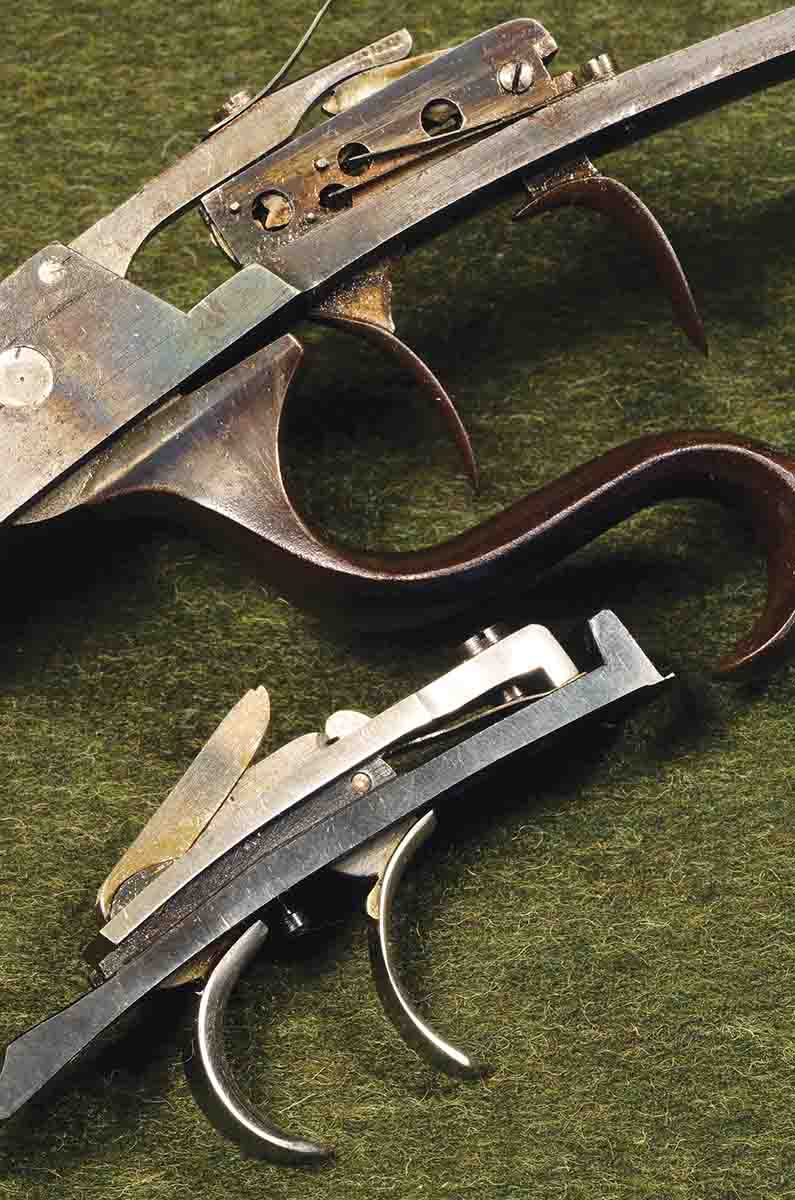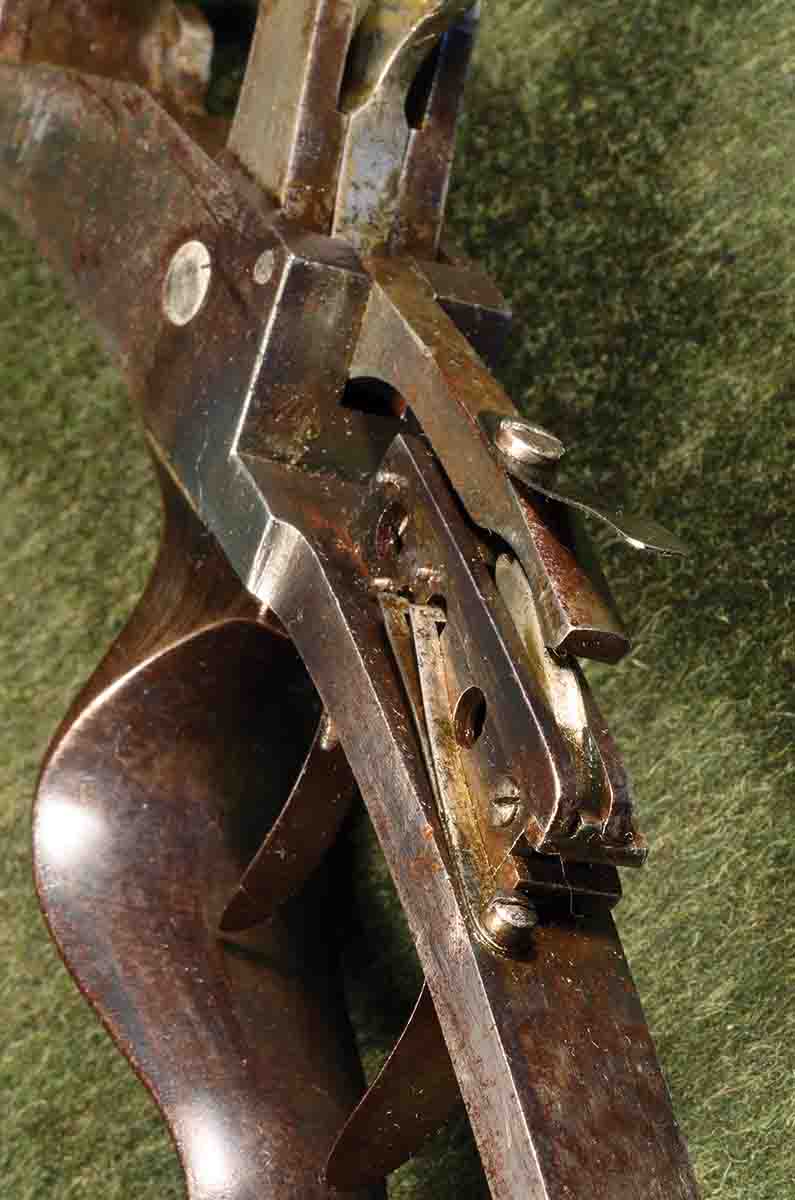Walnut Hill
Set Triggers
column By: Terry Wieland | September, 19

Me? I’m both. I’ve got set triggers that perform like well-trained dressage horses and others like rock-brained mustangs that see a rattlesnake. However – and it is a large, major and significant however – it is not their fault. Without exception, every malfunctioning set trigger I have came to me from a past owner with more screwdrivers than experience.
Therein lies the major problem with old set triggers today: People who know nothing and try to “fix” them, on the one hand, and finding someone who genuinely does know how they work to put them back on the path of righteousness. I’m not saying that the grooming of set triggers is in danger of becoming a lost art, but it’s beginning to look that way.
A set trigger can be a single- or double-trigger mechanism in which one trigger “sets” the other to go off at the touch of a feather. If the firing trigger is not set, it still releases but at a fairly heavy pull, so they can be used either way. I believe historians have found early set triggers on medieval crossbows, so they are certainly not new. Normally, they are found on target rifles, although Europeans, especially Germans and Austrians, like them on hunting rifles as well. Many of the fine Mannlicher-Schönauer hunting rifles have double-set triggers.
In Germany, it’s rare to find a Schützen rifle without a set trigger, and many (perhaps most) of the serious American Schützen rifles, like the Ballard, Stevens and Winchester, have them as well.
For reasons that escape me, set triggers have been the object of major condemnation by American gun writers over the past century. This puts them in a demonized group with double triggers and automatic safeties on shotguns. They have been described in terms usually reserved for exorcisms and witch burnings. The most charitable explanation is that the writers encountered a trigger that had been messed with and decided they were worthless.
In fact, for target shooting – and offhand matches especially – a set trigger can be a lifesaver. This is why they are found on Schützen rifles, and why experts like Harry Pope and George Schoyen admired them.
In Germany, the making of set triggers was a craft in itself, much like in England where the making of locks was left to experts like Brazier, Stanton and Chilton. A gunmaker like Boss might have its own lock design, but actual manufacture was left to specialists. Similarly, a master gunmaker in Germany could set up as a trigger man and supply set triggers to a range of gunmaker clients.
In the second volume of his three-volume opus on German Schützen rifles (Alte Scheibenwaffen, Tom Rowe, 1999-2004), Jesse Thompson tells of one such Stechermachermeister, Emil Kommer. He set up shop as a gunmaker in 1903 and stayed in business until 1966. Kommer made his last set trigger when he was 87 years old. His shop contained only one power tool, a treadle lathe that he used for making pins and screws. During his years in business (which began the year of the Wright brothers’ first flight and ended shortly before the moon landing), Kommer made triggers for such makers as Anschütz, Walther, Merkel, Geco, Büchel and Oskar Will – all famous names in firearms.

As with most aspects of German riflery, everyone seemed to have his own ideas about what worked best, and set triggers were no exception. A double-set trigger works on the principle of a tiny, spring-loaded tumbler that is released by the “hair” trigger and knocks the sear free. The setting trigger arms this hammer and moves the releasing trigger into position. It uses the principle of leverage, which is supplied by multifarious blades in the mechanism. Some German gunmakers believed that the more blades the better. Kommer told Jesse Thompson that in his experience, a five-blade mechanism was the best, most dependable and trouble free. I, for one, would take his word for that since, no matter how many diagrams I study, I still can’t quite understand how it all works.
Fortunately, you do not have to understand the mechanism to use it correctly. Unfortunately, you do need to understand it before you start monkeying with one, and therein lies the problem for many new owners of rifles with set triggers. Too many have been mangled by people who should have known better.
A common feature of German Schützens is having the trigger mechanism on a removable plate, providing for ease of cleaning, lubrication and adjustment. It is an early use of modular construction. The set triggers on Mannlicher- Schönauer rifles are also carried on a detachable plate.
The weight of pull of a modern set trigger is usually adjusted by a tiny screw that extends from the plate between the two trigger stems. This can be adjusted from noticeable to nonexistent, with the screw so far out the releasing trigger will not even set. It takes a little practice to get this right, and having it so light that it’s unsafe is obviously not a good idea. I have encountered these mechanisms where no amount of turning the screw in or out gave a good release weight, with the releasing trigger likely to go off at a glance, or not go off at all. These have been victims of those amateur gunsmiths the Brits call “bloody bodgers.”
At that point, you just hope there is a spiritual descendant of Emil Kommer in your neighborhood to take your rifle in hand and return it to good behavior. If all else fails, the gunsmiths at New England Custom Gun (NECG) have probably the most experience with European set triggers of any company in the country. Lee Shaver in Lamar, Missouri, also has wide experience with set triggers through working with older American single-shot target rifles.
Generally speaking, it’s wise to interrogate your local gunsmith before letting him touch your rifle. If you hear something like, “I’m sure I can figure it out. . .,” clutch the rifle and run. At the very least, stick around while the rifle is dismantled and keep an eagle eye on what he does. Most gunsmiths are not fond of this, but it’s your rifle and a botched job will become your problem.
Often, a tricky set trigger is caused not by mechanical problems like breakages, but by dried grease or grime that creeps into the mechanism. This is the easiest fix, although it must be done carefully. You would not start messing with a Rolex watch or a Purdey lock, so why mess with a set trigger?
When the trigger is out of the rifle, look for file marks or other signs that someone has abused it. Set-trigger mechanisms are usually as finely finished as a lock from a London “best,” and obvious tool marks are a sign of past mistreatment.
A final word: If a rifle with a set trigger is acquired, apply some patience and learn how to use it – and get used to it – before condemning it. I’ve found that when I encounter any unfamiliar mechanism in a gun, it helps if I assume that the man who designed it, and shooters who used it and liked it, were not morons, and that the system has something to recommend it. It’s usually worth the time to find out what those virtues are.


